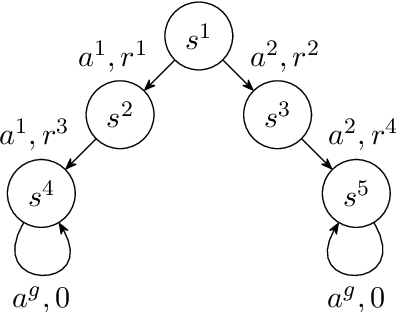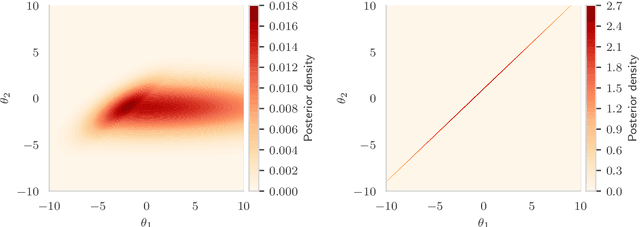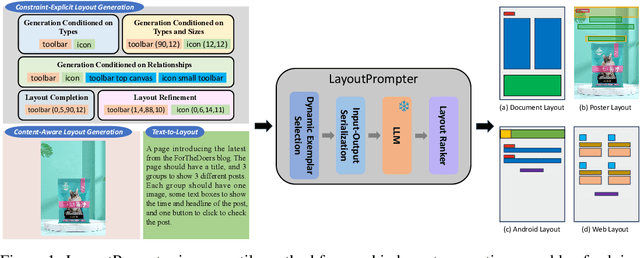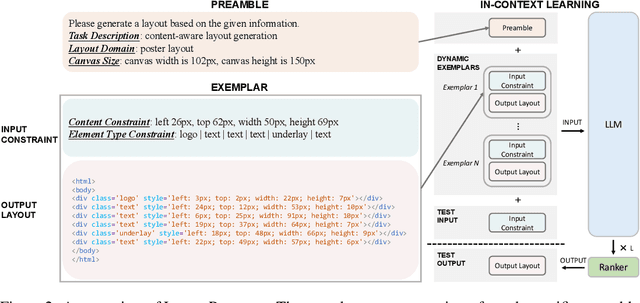Jiaqi Guo
Search Self-play: Pushing the Frontier of Agent Capability without Supervision
Oct 21, 2025Abstract:Reinforcement learning with verifiable rewards (RLVR) has become the mainstream technique for training LLM agents. However, RLVR highly depends on well-crafted task queries and corresponding ground-truth answers to provide accurate rewards, which requires massive human efforts and hinders the RL scaling processes, especially under agentic scenarios. Although a few recent works explore task synthesis methods, the difficulty of generated agentic tasks can hardly be controlled to provide effective RL training advantages. To achieve agentic RLVR with higher scalability, we explore self-play training for deep search agents, in which the learning LLM utilizes multi-turn search engine calling and acts simultaneously as both a task proposer and a problem solver. The task proposer aims to generate deep search queries with well-defined ground-truth answers and increasing task difficulty. The problem solver tries to handle the generated search queries and output the correct answer predictions. To ensure that each generated search query has accurate ground truth, we collect all the searching results from the proposer's trajectory as external knowledge, then conduct retrieval-augmentation generation (RAG) to test whether the proposed query can be correctly answered with all necessary search documents provided. In this search self-play (SSP) game, the proposer and the solver co-evolve their agent capabilities through both competition and cooperation. With substantial experimental results, we find that SSP can significantly improve search agents' performance uniformly on various benchmarks without any supervision under both from-scratch and continuous RL training setups. The code is at https://github.com/Alibaba-Quark/SSP.
RAU: Reference-based Anatomical Understanding with Vision Language Models
Sep 26, 2025Abstract:Anatomical understanding through deep learning is critical for automatic report generation, intra-operative navigation, and organ localization in medical imaging; however, its progress is constrained by the scarcity of expert-labeled data. A promising remedy is to leverage an annotated reference image to guide the interpretation of an unlabeled target. Although recent vision-language models (VLMs) exhibit non-trivial visual reasoning, their reference-based understanding and fine-grained localization remain limited. We introduce RAU, a framework for reference-based anatomical understanding with VLMs. We first show that a VLM learns to identify anatomical regions through relative spatial reasoning between reference and target images, trained on a moderately sized dataset. We validate this capability through visual question answering (VQA) and bounding box prediction. Next, we demonstrate that the VLM-derived spatial cues can be seamlessly integrated with the fine-grained segmentation capability of SAM2, enabling localization and pixel-level segmentation of small anatomical regions, such as vessel segments. Across two in-distribution and two out-of-distribution datasets, RAU consistently outperforms a SAM2 fine-tuning baseline using the same memory setup, yielding more accurate segmentations and more reliable localization. More importantly, its strong generalization ability makes it scalable to out-of-distribution datasets, a property crucial for medical image applications. To the best of our knowledge, RAU is the first to explore the capability of VLMs for reference-based identification, localization, and segmentation of anatomical structures in medical images. Its promising performance highlights the potential of VLM-driven approaches for anatomical understanding in automated clinical workflows.
Advancing Limited-Angle CT Reconstruction Through Diffusion-Based Sinogram Completion
May 26, 2025Abstract:Limited Angle Computed Tomography (LACT) often faces significant challenges due to missing angular information. Unlike previous methods that operate in the image domain, we propose a new method that focuses on sinogram inpainting. We leverage MR-SDEs, a variant of diffusion models that characterize the diffusion process with mean-reverting stochastic differential equations, to fill in missing angular data at the projection level. Furthermore, by combining distillation with constraining the output of the model using the pseudo-inverse of the inpainting matrix, the diffusion process is accelerated and done in a step, enabling efficient and accurate sinogram completion. A subsequent post-processing module back-projects the inpainted sinogram into the image domain and further refines the reconstruction, effectively suppressing artifacts while preserving critical structural details. Quantitative experimental results demonstrate that the proposed method achieves state-of-the-art performance in both perceptual and fidelity quality, offering a promising solution for LACT reconstruction in scientific and clinical applications.
Bayesian learning of the optimal action-value function in a Markov decision process
May 03, 2025



Abstract:The Markov Decision Process (MDP) is a popular framework for sequential decision-making problems, and uncertainty quantification is an essential component of it to learn optimal decision-making strategies. In particular, a Bayesian framework is used to maintain beliefs about the optimal decisions and the unknown ingredients of the model, which are also to be learned from the data, such as the rewards and state dynamics. However, many existing Bayesian approaches for learning the optimal decision-making strategy are based on unrealistic modelling assumptions and utilise approximate inference techniques. This raises doubts whether the benefits of Bayesian uncertainty quantification are fully realised or can be relied upon. We focus on infinite-horizon and undiscounted MDPs, with finite state and action spaces, and a terminal state. We provide a full Bayesian framework, from modelling to inference to decision-making. For modelling, we introduce a likelihood function with minimal assumptions for learning the optimal action-value function based on Bellman's optimality equations, analyse its properties, and clarify connections to existing works. For deterministic rewards, the likelihood is degenerate and we introduce artificial observation noise to relax it, in a controlled manner, to facilitate more efficient Monte Carlo-based inference. For inference, we propose an adaptive sequential Monte Carlo algorithm to both sample from and adjust the sequence of relaxed posterior distributions. For decision-making, we choose actions using samples from the posterior distribution over the optimal strategies. While commonly done, we provide new insight that clearly shows that it is a generalisation of Thompson sampling from multi-arm bandit problems. Finally, we evaluate our framework on the Deep Sea benchmark problem and demonstrate the exploration benefits of posterior sampling in MDPs.
NTC-KWS: Noise-aware CTC for Robust Keyword Spotting
Dec 17, 2024Abstract:In recent years, there has been a growing interest in designing small-footprint yet effective Connectionist Temporal Classification based keyword spotting (CTC-KWS) systems. They are typically deployed on low-resource computing platforms, where limitations on model size and computational capacity create bottlenecks under complicated acoustic scenarios. Such constraints often result in overfitting and confusion between keywords and background noise, leading to high false alarms. To address these issues, we propose a noise-aware CTC-based KWS (NTC-KWS) framework designed to enhance model robustness in noisy environments, particularly under extremely low signal-to-noise ratios. Our approach introduces two additional noise-modeling wildcard arcs into the training and decoding processes based on weighted finite state transducer (WFST) graphs: self-loop arcs to address noise insertion errors and bypass arcs to handle masking and interference caused by excessive noise. Experiments on clean and noisy Hey Snips show that NTC-KWS outperforms state-of-the-art (SOTA) end-to-end systems and CTC-KWS baselines across various acoustic conditions, with particularly strong performance in low SNR scenarios.
RN-SDEs: Limited-Angle CT Reconstruction with Residual Null-Space Diffusion Stochastic Differential Equations
Sep 20, 2024Abstract:Computed tomography is a widely used imaging modality with applications ranging from medical imaging to material analysis. One major challenge arises from the lack of scanning information at certain angles, leading to distorted CT images with artifacts. This results in an ill-posed problem known as the Limited Angle Computed Tomography (LACT) reconstruction problem. To address this problem, we propose Residual Null-Space Diffusion Stochastic Differential Equations (RN-SDEs), which are a variant of diffusion models that characterize the diffusion process with mean-reverting (MR) stochastic differential equations. To demonstrate the generalizability of RN-SDEs, our experiments are conducted on two different LACT datasets, i.e., ChromSTEM and C4KC-KiTS. Through extensive experiments, we show that by leveraging learned Mean-Reverting SDEs as a prior and emphasizing data consistency using Range-Null Space Decomposition (RNSD) based rectification, RN-SDEs can restore high-quality images from severe degradation and achieve state-of-the-art performance in most LACT tasks. Additionally, we present a quantitative comparison of computational complexity and runtime efficiency, highlighting the superior effectiveness of our proposed approach.
BitDistiller: Unleashing the Potential of Sub-4-Bit LLMs via Self-Distillation
Feb 16, 2024Abstract:The upscaling of Large Language Models (LLMs) has yielded impressive advances in natural language processing, yet it also poses significant deployment challenges. Weight quantization has emerged as a widely embraced solution to reduce memory and computational demands. This paper introduces BitDistiller, a framework that synergizes Quantization-Aware Training (QAT) with Knowledge Distillation (KD) to boost the performance of LLMs at ultra-low precisions (sub-4-bit). Specifically, BitDistiller first incorporates a tailored asymmetric quantization and clipping technique to maximally preserve the fidelity of quantized weights, and then proposes a novel Confidence-Aware Kullback-Leibler Divergence (CAKLD) objective, which is employed in a self-distillation manner to enable faster convergence and superior model performance. Empirical evaluations demonstrate that BitDistiller significantly surpasses existing methods in both 3-bit and 2-bit configurations on general language understanding and complex reasoning benchmarks. Notably, BitDistiller is shown to be more cost-effective, demanding fewer data and training resources. The code is available at https://github.com/DD-DuDa/BitDistiller.
Training-Free Semantic Video Composition via Pre-trained Diffusion Model
Jan 17, 2024



Abstract:The video composition task aims to integrate specified foregrounds and backgrounds from different videos into a harmonious composite. Current approaches, predominantly trained on videos with adjusted foreground color and lighting, struggle to address deep semantic disparities beyond superficial adjustments, such as domain gaps. Therefore, we propose a training-free pipeline employing a pre-trained diffusion model imbued with semantic prior knowledge, which can process composite videos with broader semantic disparities. Specifically, we process the video frames in a cascading manner and handle each frame in two processes with the diffusion model. In the inversion process, we propose Balanced Partial Inversion to obtain generation initial points that balance reversibility and modifiability. Then, in the generation process, we further propose Inter-Frame Augmented attention to augment foreground continuity across frames. Experimental results reveal that our pipeline successfully ensures the visual harmony and inter-frame coherence of the outputs, demonstrating efficacy in managing broader semantic disparities.
Contrastive Learning With Audio Discrimination For Customizable Keyword Spotting In Continuous Speech
Jan 12, 2024Abstract:Customizable keyword spotting (KWS) in continuous speech has attracted increasing attention due to its real-world application potential. While contrastive learning (CL) has been widely used to extract keyword representations, previous CL approaches all operate on pre-segmented isolated words and employ only audio-text representations matching strategy. However, for KWS in continuous speech, co-articulation and streaming word segmentation can easily yield similar audio patterns for different texts, which may consequently trigger false alarms. To address this issue, we propose a novel CL with Audio Discrimination (CLAD) approach to learning keyword representation with both audio-text matching and audio-audio discrimination ability. Here, an InfoNCE loss considering both audio-audio and audio-text CL data pairs is employed for each sliding window during training. Evaluations on the open-source LibriPhrase dataset show that the use of sliding-window level InfoNCE loss yields comparable performance compared to previous CL approaches. Furthermore, experiments on the continuous speech dataset LibriSpeech demonstrate that, by incorporating audio discrimination, CLAD achieves significant performance gain over CL without audio discrimination. Meanwhile, compared to two-stage KWS approaches, the end-to-end KWS with CLAD achieves not only better performance, but also significant speed-up.
LayoutPrompter: Awaken the Design Ability of Large Language Models
Nov 11, 2023



Abstract:Conditional graphic layout generation, which automatically maps user constraints to high-quality layouts, has attracted widespread attention today. Although recent works have achieved promising performance, the lack of versatility and data efficiency hinders their practical applications. In this work, we propose LayoutPrompter, which leverages large language models (LLMs) to address the above problems through in-context learning. LayoutPrompter is made up of three key components, namely input-output serialization, dynamic exemplar selection and layout ranking. Specifically, the input-output serialization component meticulously designs the input and output formats for each layout generation task. Dynamic exemplar selection is responsible for selecting the most helpful prompting exemplars for a given input. And a layout ranker is used to pick the highest quality layout from multiple outputs of LLMs. We conduct experiments on all existing layout generation tasks using four public datasets. Despite the simplicity of our approach, experimental results show that LayoutPrompter can compete with or even outperform state-of-the-art approaches on these tasks without any model training or fine-tuning. This demonstrates the effectiveness of this versatile and training-free approach. In addition, the ablation studies show that LayoutPrompter is significantly superior to the training-based baseline in a low-data regime, further indicating the data efficiency of LayoutPrompter. Our project is available at https://github.com/microsoft/LayoutGeneration/tree/main/LayoutPrompter.
 Add to Chrome
Add to Chrome Add to Firefox
Add to Firefox Add to Edge
Add to Edge